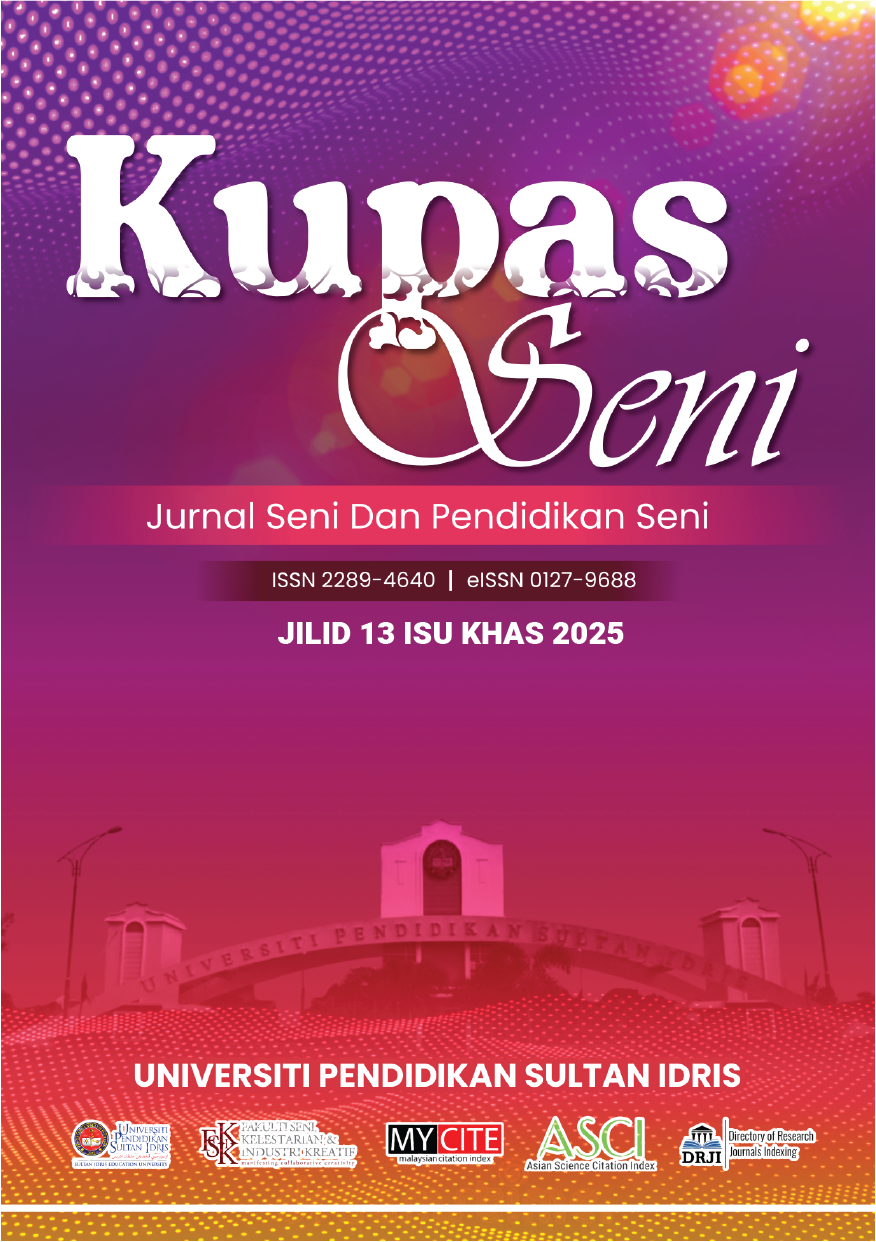The Development of an Artificial Intelligence Technology Teaching Model to Improve Secondary School Student's Creativity Skills During Ideation Process in Visual Arts Education (VAE) Subject: A Need Analysis
DOI:
https://doi.org/10.37134/kupasseni.vol13.sp.3.2025Keywords:
Artificial Intelligence, ideation process, need analysis, Visual Art Education, creativityAbstract
This study explores the need for developing an integrated Artificial Intelligence (AI) technology teaching model to enhance secondary school students' creativity during the ideation process in Visual Arts Education (VAE). The research focuses on addressing challenges faced by VAE teachers in Malaysia, particularly in the Kajian Rekaan Seni Visual (KRSV) component of the Sijil Pelajaran Malaysia (SPM) examination. Employing a quantitative methodology, the study utilized a survey questionnaire administered to sixty-eight VAE secondary school teachers in Selangor. Data analysis, conducted using descriptive statistics to examine means and frequencies, revealed that a significant majority of teachers acknowledge the necessity to enhance students' creative competencies and recognize inefficiencies in the current ideation process. Teachers report that students heavily rely on provided examples and experience stress during ideation, potentially contributing to increase the numbers of dropouts addressed as ‘T’ students. The study identifies a strong demand for AI-integrated approaches to facilitate a more effective ideation process and provide personalized guidance to students. Based on these findings, the researchers propose the development of an 'Ideation Intelligence' model, which aims to integrate AI technology with the current ideation methods. This model seeks to reduce ideation time while enhancing the quality of creative outcomes, ultimately fostering students' creative growth and preventing dropouts from KRSV.
Downloads
References
Brisco, R., Hay, L., & Dhami, S. (2023). Exploring the role of text-to-image AI in concept generation. Proceedings of the Design Society, 3, 1835–1844. https://doi.org/10.1017/pds.2023.184
Chen, L., Wang, P., Dong, H., Shi, F., Han, J., Guo, Y., Childs, P. R. N., Xiao, J., & Wu, C. (2019). An artificial intelligence-based data-driven approach for design ideation. Journal of Visual Communication and Image Representation, 61, 10–22. https://doi.org/10.1016/j.jvcir.2019.02.009
Dehouche, N., & Dehouche, K. (2023). What’s in a text-to-image prompt? The potential of stable diffusion in visual arts education. Heliyon, 9(6), e16757. https://doi.org/10.1016/j.heliyon.2023.e16757
Karaata, E. (2018). Usage of artificial intelligence in today’s graphic design. Online Journal of Art and Design, 6(4). https://www.researchgate.net/publication/331431169
Karimi, P., Rezwana, J., Siddiqui, S., Maher, M. L., & Dehbozorgi, N. (2020). Creative sketching partner: An analysis of human-AI co-creativity. International Conference on Intelligent User Interfaces, Proceedings IUI, 221–230. https://doi.org/10.1145/3377325.3377522
Keisling, M. D. (2019). A minoritized art teacher’s perspective on teacher leadership: Teacher leadership through community leadership and collaborative efforts. International Journal of Teacher Leadership, 4(2).
McCrae, R. R. (1987). Creativity, divergent thinking, and openness to experience. Journal of Personality and Social Psychology, 52(6), 1258–1265.
Orthel, B. D., & Day, J. K. (2016). Processing beyond drawing: A case study exploring ideation for teaching design. SAGE Open, 6(3). https://doi.org/10.1177/2158244016663285
Rahmat, M. K., & Au, W. K. (2017). Integrating technology into art classrooms: Does the Malaysia visual art education teachers ready? International Journal of Education, 2(5). www.ijepc.com
Shrotryia, V. K., & Dhanda, U. (2019). Content validity of assessment instrument for employee engagement. SAGE Open, 9(1). https://doi.org/10.1177/2158244018821751
Tomc, H. G., & Kočevar, T. N. (2020). Observation on creativity and spatial visualisation skills of graphic arts’ students. International Symposium on Graphic Engineering and Design, 561–569. https://doi.org/10.24867/GRID-2020-p63
Wong, S. (2022). Reflecting on ‘impact’ in artist–academic collaborations in times of conflict. Journal of Humanitarian Affairs, 4(2), 32–39. https://doi.org/10.7227/jha.088
Downloads
Published
Issue
Section
License
Copyright (c) 2025 Faten Fadzillah Mohd Zuhairi, Mohd Khairezan Rahmat, Roslaili Anuar

This work is licensed under a Creative Commons Attribution-NonCommercial-ShareAlike 4.0 International License.





